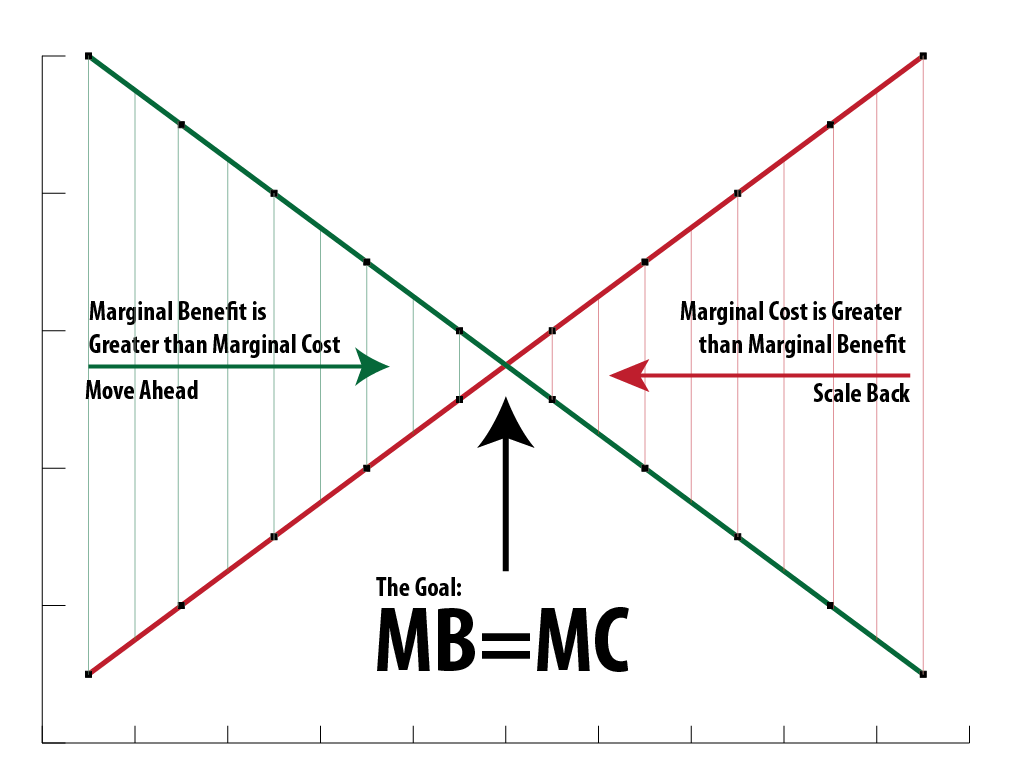In economics, one of the primary measuring sticks for making decisions is weighing marginal benefits and marginal costs.
What do we mean by the word marginal? In simplest terms, the word marginal means ‘one more.’ For example if I consider eating one more slice of pizza, I ask myself, what is the benefit of one more slice of pizza? What is the cost of eating one more slice of pizza?
Some benefits might take the form of enjoying the flavor, satisfying hunger pains or the satisfaction that you stole the last piece from your brother.
Some of the marginal costs involved might be heartburn later in the evening, added weight, increased oil build-up on your face, or the emotional distress caused when your brother argues with you over why you always get to have the last piece.
When the cost of ‘one more’ begins to pass the benefit of ‘one more,’ it’s time to stop.
The optimization rule is simply marginal benefit=marginal cost, or
MB=MC
As long as marginal benefit exceeds marginal cost, keep consuming. But when you arrive at MB=MC, you’ve reached an optimal consumption:
This is easier when money is involved, because it’s comparing apples to apples, or dollars to dollars. It gets harder in our daily lives when, for example, we might be trying to figure out the marginal benefit of extra hours at the office. The marginal benefit might be more money but the cost is likely time with our families and children. How do you quantify the value of that?
We have to make decisions like this every day. It’s important to realize that not all benefits and costs are readily visible. Like President Packer’s Spiritual Crocodiles, there could be physical or spiritual costs laying nearly invisible just below the surface. These, if not accounted for, can completely overwhelm us. Nor can we fully estimate the impact of a single missionary moment, where we were willing to share the gospel or follow through on a prompting to server another.
In economics we discuss the short-run and the long-run. In Gospelnomics we add a dimension: the eternal.
In a spot-on devotional address to students at BYU, Elder Oaks discoursed on the value of considering the implications (which we’ve identified here as marginal costs and benefits) of our decisions. Dallin H. Oaks taught,
Potentially destructive deviations often seem so small that some find it easy to justify “just this once.” When that temptation arises–as it will–I urge you to ask yourself, “Where will it lead? . . . I [suggest] this [is] a valuable question against which we can measure many personal and private decisions,” (BYU Devotional, “Where will it lead?” 9 November, 2004).
My sole purpose today is to recommend this talk. I’ve been personally benefited by his message and I know it to be true. I invite you to take some time this weekend to read it, watch it or listen to it. Be sure to come back afterwards and comment on what you thought.
Thanks for reading.

This is an awesome post. I am excited that you guys are having a baby soon.
Thanks Iuliana!
I didn’t know you wrote this untill the end MB=MC very wonderful perspective!